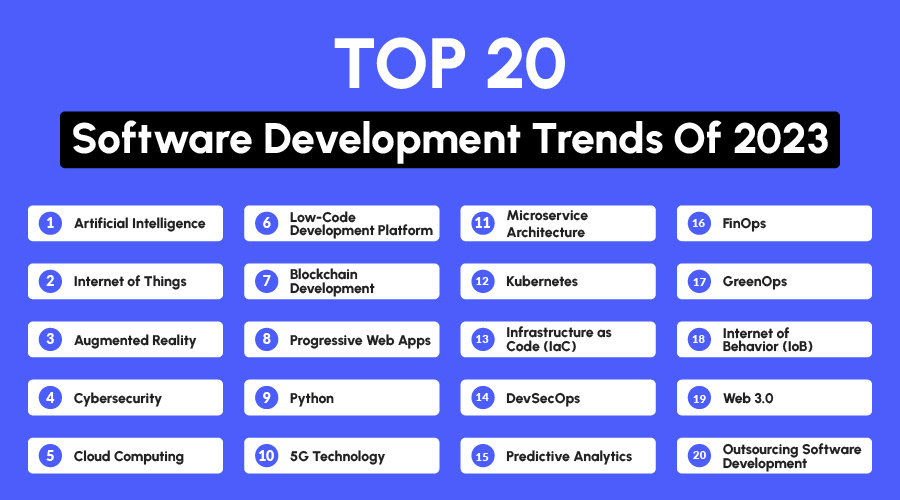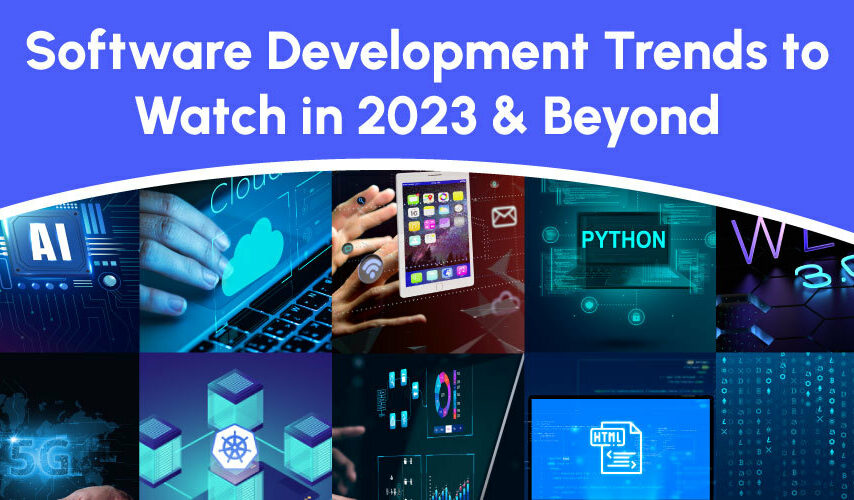The development world moves at the speed of light.
As a business owner, staying ahead of the curve by adapting to the latest software development trends can help you succeed in the fast-paced market.
According to the latest surveys, around 70% of businesses have prioritized digital transformation by increasing their software investments in 2023. This clearly shows the rising demand for emerging technologies in software development.
Today, companies focus on contactless services, cloud migration, DevOps activities, etc. Additionally, AI-enabled apps, grocery and food delivery apps, and more are becoming the new normal with the help of software development.
To learn more about what software development trends businesses can expect in 2023 and beyond, we have compiled 20 research-backed trends to discover.
Let’s have a look at them.
The Top 20 Software Development Trends Of 2023

1. Artificial Intelligence
In recent years, Artificial Intelligence has become popular in software development. It automates routine tasks, builds predictive models, improves user experience, and enables data-driven decision-making.
It is expected that AI can play a huge role in developing more intelligent, responsive, and groundbreaking applications.
Latest AI Development Trends To Leverage In 2023
1. Automated Machine Learning
2. Generative AI
3. Natural Language Processing (NLP)
4. Ethical AI
5. AI-as-a-Service (AIaaS)
2. Internet of Things
The Internet of Things is evolving constantly and expanding opportunities for companies and developers. It refers to connected networks of various objects like gadgets, devices, vehicles, appliances, etc. that are embedded with sensors, software, and other technologies. These devices use APIs for exchanging data over the Internet.
From predictive analytics through machine learning algorithms to automation enabled by edge computing, the Internet of Things uses are wide. A few of its uses are predictive maintenance, asset tracking, connected vehicles, fleet management, and smart meters.
3. Augmented Reality
Augmented reality is a rapidly used technology in software development for creating interactive user experiences by combining the natural world and computer-generated content.
It is used for a wide range of applications such as gaming, entertainment, and education; however, recently has been playing a pivotal role in the E-commerce industry for transforming business and consumer interaction.
In 2023, businesses can leverage AR’s interesting features like try-on tools, 3D modeling, digital showroom, and more to enhance the user shopping experience.
4. Cybersecurity
Security threats and cyber attacks are common these days and can pose many security risks through various attacks, such as phishing attacks, DDoS, etc.
Hence, cybersecurity is an important consideration when it comes to developing an application, as it helps protect systems, networks, and programs from malicious attacks.
Cybersecurity technology helps design applications that proactively mitigate and tackle potential risks from digital attacks.
5. Cloud Computing
With more and more businesses and government organizations leveraging cloud technology for software development, it’s clear to say that Cloud Computing is going to be used actively in the coming years.
Cloud computing has become the most prominent software development trend at the global level. Investing in this technology can help build more scalable, flexible, and productive cloud-native solutions that run on multiple servers.
6. Low-Code Development Platform
Low-code development platforms are gaining popularity among businesses and developers. Low code/ no code development is a new approach to developing software solutions quickly and easily.
These LCNC platforms allow developers to develop software without having traditional coding skills through graphical user interfaces and configuration.
Low code development brings a range of benefits like cost and time savings, manual work reduction, lower entry barriers, etc.
7. Blockchain Development
Blockchain technology is renowned for its uses in cryptocurrency; however, due to its diverse potential, it’s now one of the key trends in the software development industry.
In particular, blockchain technology offers exceptional security features, transparency, and decentralization enabling developers to create highly secure and transparent software products.
Blockchain technology has been widely implemented for enterprise software systems and many other sectors. Some of its uses are developing:
- Supply chain monitoring systems for the automotive, logistics, and agriculture industries.
- Accounting software systems for tracing energy consumption.
- Software products for secure electronic voting.
- Analytics software for providing accurate insights and forecasts.
- Decentralized apps
- Secure apps with robust security features.
8. Progressive Web Apps
Recently, Progressive Web Apps is getting highly embraced by businesses to create attractive and responsive websites. The reason behind the relevance and popularity of Progressive Web Apps is it allows building sites that give mobile-like experiences for the best performance, user engagement, and experience.
Progressive Web Apps is the right choice for businesses with low budgets as only one codebase is needed to develop and maintain. They are speedy, secure, and responsive and deliver a user experience that’s partly similar to native mobile applications.
9. Python
The top software trends list can’t be completed without Python. It is a dynamic language capable of performing multiple tasks and can handle complex jobs with superior efficiency.
Python is among the favorite programming languages of developers for building software applications with AI and ML-based features. Additionally, Python allows performing data analysis, machine learning, mathematical operations, and much more.
5 Top Python Trends To Look After In 2023
1. Artificial Intelligence and Machine Learning Applications
2. Python in Game Development
3. Python for IoT and the Internet of Things
4. Web and Mobile Application Development
5. Automation and Robotization
10. 5G Technology
5G technology is no doubt among the top software development trends for 2023. It is a redefined network architecture for digital world communication and interaction.
5G connectivity allows companies to realize the full potential of software development technologies, such as the Internet of Things, Augmented Reality, and Artificial Intelligence (AI).
This superior 5th-generation standard of mobile connectivity promises numerous benefits, such as high speed, low latency, energy efficiency, and ubiquitous coverage.
11. Microservice Architecture
Microservices architecture is used by developers to create single-function modules with precise interfaces using lightweight APIs.
It enables organizations to develop large and complex software rapidly and reliably. The application developed using microservice architecture is a collection of small independent services where each service of the application performs a single function.
There are multiple advantages of microservices like
- Easy to manage
- High Scalability
- It reduces dependencies
- It’s easy to add new features
- The entire application doesn’t get affected by a single microservice page down
12. Kubernetes
Another trend to look forward to in software development in 2023 is gaining popularity of Kubernetes. Also known as K8 or Kube, Kubernetes is an open-source container orchestration platform that automates operational tasks of container management, such as scaling, deploying, monitoring, and managing applications.
Kubernetes is mainly used for creating easy to manage and deployable applications. Moreover, it allows faster development, deploying applications anywhere, adjusting cluster size to run service, and scaling applications.
Other than applications, there is a wide range of Kubernetes benefits, listed a few below:
- Can handle high workloads
- Reduces cloud complexity
- Automates operations
- Continuous service health monitoring
13. Infrastructure as Code (IaC)
IaC is a primary DevOps approach that enables businesses to manage and automate IT infrastructure via various configuration files. For developers, it allows managing, analyzing, and provisioning resources automatically.
It is a process of using code to automate, manage, and configure dynamic computing resources to eliminate management issues.
DevOps team can create a single and trustable code base using IaC that will allow them to track app deployment and fix vulnerabilities easily.
14. DevSecOps
DevOps is well known in software development; however, according to current software development trends, there is rising adoption of the DevSecOps concept.
DevSecOps breaks down into development, security, and operation. It’s an evolution of DevOps and an innovative approach to integrating in-built security and compliance in applications.
Security is an integral part of software development; hence, DevSecOps ensure strong security standards to identify and eliminate errors at early stages.
15. Predictive Analytics
With the recent technological advancement, businesses globally have started understanding the significance of Predictive Analytics and how it can help their business.
Predictive Analytics allows organizations to predict events by analyzing the previous history. This works by collecting a large amount of data based on past events and structuring them to help businesses anticipate future patterns, market trends, and consumer behaviors more informed and effectively.
With the gaining momentum of Predictive Analytics, there is rising demand for predictive maintenance as well. This maintenance is usually based on constant data analysis where software analyzes the past and present state of equipment or business and predicts its downtime.
This information helps the maintenance team to resolve the issues before any loss and allows taking necessary actions.
Other Popular Software Development Trends In 2023
Yes, there’s more to the above list.
16. FinOps
FinOps is an evolving cloud financial management practice allowing businesses to optimize their financial performance and processes with high efficiency.
17. GreenOps
GreenOps refers to a cloud operating model that focuses on implementing eco-friendly technologies, techniques, and practices to maximize long-term business value.
18. Internet of Behavior (IoB)
IoB is a collection of data to drive users’ behavior and interests. It is expected for IoT to acquire broad momentum in the coming years as the major global population will have their activities tracked.
19. Web 3.0
Web 3.0 are responsive and dynamic applications developed using JavaScript development. These applications are currently compatible with browsers and mobile devices; however, in the coming years, it can be seen that Web 3.0 applications will be compatible with all devices.
20. Outsourcing Software Development
Outsourcing software development has become the latest buzz. Many businesses nowadays are opting for outsourcing as it is cost-effective and provides increased flexibility.
Summing Up – Trends in Software Development
The software development industry is constantly evolving to meet the needs of consumers. As long as you’re keeping up with trends, your business won’t fall behind.
The above-listed 20 Software Development trends mainly focus on improving user experience and the productivity of business processes. Staying on top of these trends will ensure your software applications constantly attract and engage customers.
However, many businesses face difficulties adapting to these trends; hence, a powerful software development team by your side can help you adapt to these trends easily.
Working with the best software development company will help your business transform digitally according to your needs and challenges.








